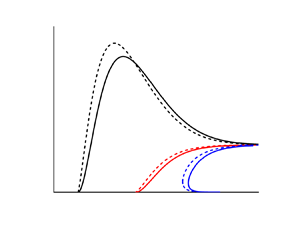Article contents
Theoretical analysis on the transient ignition of a premixed expanding flame in a quiescent mixture
Published online by Cambridge University Press: 11 August 2021
Abstract

The ignition of a self-sustained premixed expanding flame constitutes a crucial problem in fundamental combustion research. In this work, a transient formulation on the forced ignition of a premixed expanding spherical flame in a quiescent mixture is proposed under the framework of the thermal-diffusive model. The present theory considers the unsteady evolution of the temperature and fuel mass fraction distributions subject to finite duration central heating. It can determine both critical heating power and minimum ignition energy for successful ignition. The transient flame initiation process is found to consist of four stages, including fast establishment of the ignition kernel, ignition-energy-supported flame kernel propagation, unsteady transition of the flame kernel, and quasi-steady spherical flame propagation. The unsteady effects lead to the observation of flame kernel establishing stage and considerably affect the subsequent flame kernel development by altering the flame propagation speed. Time scale analysis indicates that the transient formulation completely degenerates to the quasi-steady theory in the limits of both stationary flame ball and planar flame. Previous quasi-steady theory shows that the critical heating power for successful ignition is proportional to the cube of the critical flame radius. However, that scaling relation shall be revised in the transient formulation due to the unsteady thermal conduction from heating centre to flame front. The memory effect that persistently supports flame propagation subsequent to switching off the central heating is examined. It is found that as the heating power grows, the memory effect becomes increasingly important, and it can greatly reduce the predicted minimum ignition energy.
JFM classification
- Type
- JFM Papers
- Information
- Copyright
- © The Author(s), 2021. Published by Cambridge University Press
References
- 15
- Cited by



